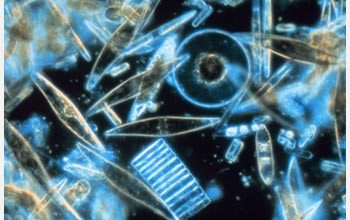
Nutrition
Diatoms are mostly phototrophic organism with
a few species that are mixatrophic and even fewer that are solely
heterotrophic. With nutrients and growth factors, they require all
the same ones that other eukaryotic organisms do but on top of that
they also require greater amounts silicon, for their frustules. They
obtain this silicon from the environment where it is dissolved in
the form of silicic acid.
The oceans usually sufficient silicic acid concentration for
diatoms to grow effectively but there is rather large areas where
iron concentrations are low which leads to limited growth in
diatoms. This usually only occurs in open waters.
Unlike with land plants the carbon that diatoms fix almost
never goes into long term storage. Instead it ends up being used for
cell division and reproduction or they get eaten as a strong base
for marine and aquatic ecosystems.
Some diatoms aren’t sole photoautotrophic. The species that
can be heterotrophic are mostly pennale species that live in the
benthic regions. In polar waters they have been found in a confusing
symbiosis with sponges. The symbiosis a mutualism and a parasitism
part to it. The mutualism part of the symbiosis occurs when the
diatoms are able to have enough light to produce the energy to cover
their metabolic demand that; well, the parasitic part occurs when
the diatoms are unable to produce enough energy to cover their
metabolic demand they shift to eating the sponge, so in low light to
no light conditions. During the mutualism part of the symbiosis the
sponges provides protection to the diatoms from predation and the
diatom s
provide energy in the form of extracellular polysaccharides, which
most diatoms produce, and they assist as support for the sponge. But
during the parasitic part of the symbiosis the diatoms being unable
to fulfill their metabolic demand begin to consume the sponge to
prevent them from becoming vegetative and allowing them to continue
to divide. The diatoms in these situations end up being facultative
parasite and facultative mutualism depending on time of year and if
the area in which the host sponge is growing has sufficient light to
prevent the diatoms from becoming parasitic. (Also can be seen in
Interactions) (For more indepth
information
http://www.biolbull.org/cgi/reprint/198/1/29.pdf).
s
provide energy in the form of extracellular polysaccharides, which
most diatoms produce, and they assist as support for the sponge. But
during the parasitic part of the symbiosis the diatoms being unable
to fulfill their metabolic demand begin to consume the sponge to
prevent them from becoming vegetative and allowing them to continue
to divide. The diatoms in these situations end up being facultative
parasite and facultative mutualism depending on time of year and if
the area in which the host sponge is growing has sufficient light to
prevent the diatoms from becoming parasitic. (Also can be seen in
Interactions) (For more indepth
information
http://www.biolbull.org/cgi/reprint/198/1/29.pdf).
To reproduction